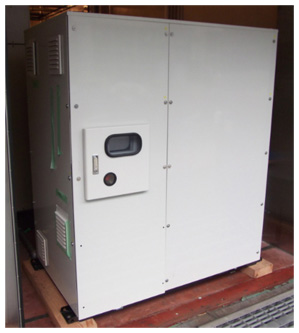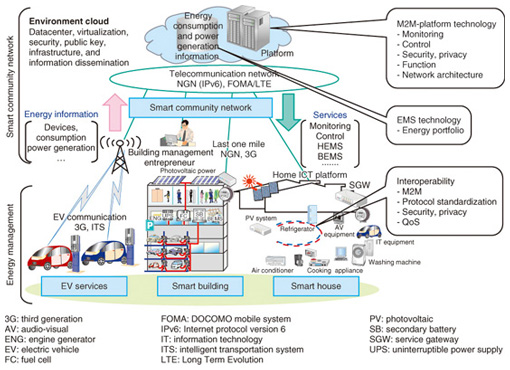 |
|||||||||||||||||
|
|
|||||||||||||||||
|
Feature Articles: Technologies for Managing Smart Energy Vol. 10, No. 1, pp. 6–10, Jan. 2012. https://doi.org/10.53829/ntr201201fa1 Research and Development of Smart EnergyAbstractThis article introduces the status of research and development being performed by NTT Energy and Environment Systems Laboratories based on the concept of information and communications technology (ICT) combined with energy called "ICT × energy". This should lead to systems capable of ensuring stable power supply, saving energy, and shifting load peaks as well as to technologies that use smart energy management.
1. IntroductionThe smart grid is a concept that is attracting attention as a key technology for improving the stability of power supplies and solving global environmental problems. This concept has mainly been discussed in the USA and Europe, but there has also been active discussion in Japan, China, and Korea. The smart grid, which is outlined in Fig. 1 [1], connects commercial power plants to distributed generation systems, batteries, and various kinds of industrial and private equipment installed at the sites of power consumers through communication networks. It enables new energy-saving functions not available from the conventional power networks, such as meticulous adjustment of power demand and supply; promotes the implementation of photovoltaic power, wind power, and other renewable energies; and enables the visualization of power consumption. There are global expectations for the smart grid: to run power networks stably by suppressing peak power demand in the USA; to implement wind power and other renewable energies on a large scale in Europe; to improve the energy self-supply ratio and foster new growing export industries in Korea; and to strengthen power networks and utilize thermal, hydraulic, and nuclear power efficiently in China and India.
In Japan, the Great East Japan Earthquake in March 2011 activated discussion about reviewing the basic energy policies and increased the importance of business continuity plans for disasters. The smart grid is now expected to also be a means of suppressing peak power demand and balancing demand and supply. To date, NTT Energy and Environment Systems Laboratories has been promoting comprehensive research and development (R&D) activities from the two viewpoints of Green of ICT and Green by ICT [2] to reduce environmental loads (ICT: information and communications technology). In particular, R&D activities are gaining speed these days to contribute to service development for the smart community that the NTT Group is promoting. 2. Position of smart gridThe smart grid has three purposes: (1) reducing CO2 emissions accompanying power supply, (2) increasing efficiency by controlling the balance between power demand and supply, and (3) improving reliability by power management. In the power field, the smart grid is an innovation like the Internet in the ICT field. More specifically, the advent of the Internet in 1990s caused a quick evolution of ICT services from the age of communications by phone to the age of business creation via the Internet. This may be why we are aiming at the Internet of things. The position of the smart grid in power supply is shown in Fig. 2. Power supply used to be only one way from a power plant (supplier) to consumers. By contrast, the smart grid can produce various unique effects from two-way power supply by photovoltaic generation on the consumer side, by distributed generation using fuel cells, and by power storage using batteries as well as unique effects from N-way flow (two-way mesh form) by power and information exchange among consumers. This age of business creation arises from this evolution from centralized generation and one-way transmission & generation to distributed generation and two-way transmission & distribution. NTT Energy and Environment Systems Laboratories is tackling the development of technology needed for the smart grid not from the viewpoint of a power supplier by from the viewpoint of users (demand side).
3. Development of smart energy management technology from demand-side viewpointThe smart grid in its true form will allow information and power exchange in two ways or finally in N ways (mesh form). NTT’s business area covers smart communities and smart houses and buildings through close linkage between energy and ICT. The smart grid viewed from the demand side is shown in Fig. 3. NTT is developing technologies for smart communities based on the concept of “ICT × energy” by combining ICT (Next Generation Network (NGN), FLET’S HIKARI (optical broadband service), mobile and other network infrastructures, Home ICT, etc.) and energy devices such as photovoltaic and wind-generation devices, batteries, and fuel cells. More specifically, NTT is developing (1) optimum control systems for power- and heat-exchange systems and new energy systems within the smart community and (2) a demand-side management system (demand-based power management system), home energy management system (HEMS), building energy management system (BEMS), and datacenter energy management system (DEMS), and a new energy-producing home appliance control system for using home photovoltaic generation systems, fuel cells, and electric vehicle batteries optimally for smart houses and buildings. Regarding energy devices, NTT is developing solid oxide fuel cells (SOFCs) having the highest generating efficiency and lowest CO2 emissions among various fuel cells and also next-generation batteries after the lithium ion battery.
For SOFCs, NTT is promoting joint development with Sumitomo Precision Products and Toho Gas, putting priority on the cell and stack as the heart of an SOFC. With the 5-kW-class system shown in Fig. 4, we have achieved the world’s highest level of power generation efficiency of 45% and are now reducing the costs and extending the life for commercialization.
Regarding batteries to come after the lithium ion battery, NTT is studying materials for a lithium air battery to achieve space savings and a lightweight power supply in the future. Considering the theoretical capacity based on the present combination of anode and cathode materials, it is said that lithium ion battery capacity cannot be increased more than 1.6 times. Compared with the lithium ion battery, the lithium air battery is expected to be several times more compact and lightweight. 4. Conceptual model of smart gridThe key points for a smart community are visualizing and optimally controlling the power generation and consumption of various energy devices. The significance of establishing a foundation for visualization and control is self-evident. NTT is advocating the smart conceptual model shown in Fig. 5. The total strength of NTT R&D should be focused to develop technology such as a machine-to-machine (M2M) platform technology, energy management system (EMS) technology (energy portfolio technology) for the optimum control of power supply and demand based on a great volume of power generation and consumption information, and interconnection technology for various devices in smart houses and buildings.
Toward a clean energy network, NTT Energy and Environment Systems Laboratories participated in clean energy demonstration research [3] at EXPO 2005 AICHI JAPAN and provided an energy control system [4], including the algorithm for achieving optimum scheduling of fuel cells and sodium-sulphur batteries based on meteorological information. NTT is also promoting R&D of higher-voltage direct current (HVDC) [5] and other energy-conservation technology [6] for energy-saving devices and systems; clean-energy technology, such as fuel cells [7], new batteries, and solar batteries of ultrahigh efficiency; and also clean-tech R&D technology for zero CO2 emissions. By further accelerating R&D activities on the basis of these experiences, we wish to contribute to the creation of a smart community through clean technology. From a carrier’s viewpoint, the important points of smart grid construction may be controlling the quality of service (QoS) and the class of service (CoS) for secure and safe network service and accommodating various protocols and devices. Needless to say, the key to spreading and promoting the smart grid is promoting standardization. With the cooperation of other NTT laboratories concerned, NTT Energy and Environment Systems Laboratories is also promoting standardization related to the smart grid. References
|
|||||||||||||||||













